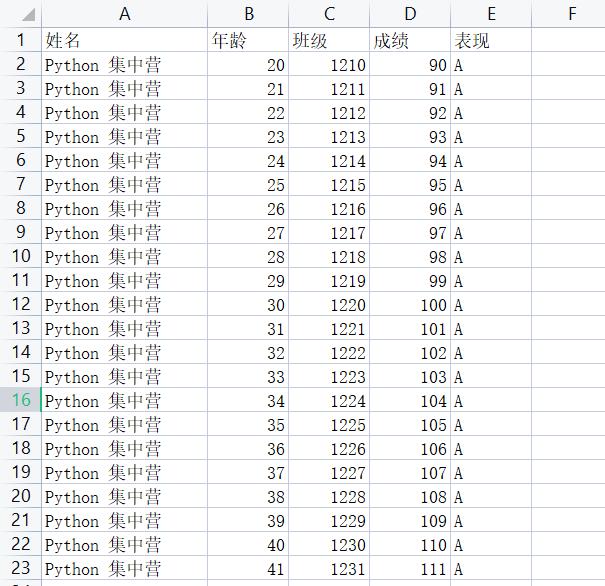常规的Excel数据处理中,就是对Excel数据文件的读/写/文件对象操作。
通过对应的python非标准库xlrd/xlwt/xlutils,来实现具体的数据处理业务逻辑。
在复杂的Excel业务数据处理中,三兄弟扮演的角色缺一不可。如何能够使用xlrd/xlwt/xlutils三个模块来实现数据处理就是今天的内容。
1、模块说明
使用该三个模块来处理Excel数据最好的地方就是他们和Excel文件对象对应的数据处理概念是一样的,能更好的便于我们理解数据对象。
首先,这三个模块都是python的非标准库,可以选择pip的方式来进行安装。
pip install xlrd pip install xlwt pip install xlutils
下面是我们为演示数据处理的过程准备的源数据内容,只是用于测试。
xlrd:用于读取Excle数据文件将返回的数据对象放到内存中,然后查询数据文件对象的相关信息。
xlwt:用于在内存中生成新的数据文件对象,处理完成后写入到Excel数据文件中。
xlutils:主要的作用就是copy新的文件对象,在新的数据对象中完成数据处理操作。
将xlrd/xlwt/xlutils三个模块分别都导入到待开发的代码块中提供支持。
# Importing the xlrd module. import xlrd as read # Importing the xlwt module. import xlwt as write # Copying the contents of the original workbook into a new workbook. from xlutils.copy import copy
2、xlrd处理
# Opening the workbook and assigning it to the variable `work_book`.
work_book = read.open_workbook('D:/test-data-work/test.xls')
# Assigning the sheet named 'Sheet1' to the variable `sheet`.
sheet = work_book.sheet_by_name('Sheet1')
# `row = sheet.nrows` is assigning the number of rows in the sheet to the variable `row`.
row = sheet.nrows
# `col = sheet.ncols` is assigning the number of columns in the sheet to the variable `col`.
col = sheet.ncols
print('Sheet1工作表有:{0}行,{1}列'.format(str(row), str(col)))
# Sheet1工作表有:23行,5列
下面是三种常用的sheet对象的数据遍历方式,分别是按行/列的方式进行数据遍历。
for a in sheet.get_rows(): print(a) # [text:'姓名', text:'年龄', text:'班级', text:'成绩', text:'表现'] # [text:'Python 集中营', number:20.0, number:1210.0, number:90.0, text:'A'] # [text:'Python 集中营', number:21.0, number:1211.0, number:91.0, text:'A'] # [text:'Python 集中营', number:22.0, number:1212.0, number:92.0, text:'A'] # [text:'Python 集中营', number:23.0, number:1213.0, number:93.0, text:'A'] # [text:'Python 集中营', number:24.0, number:1214.0, number:94.0, text:'A'] # [text:'Python 集中营', number:25.0, number:1215.0, number:95.0, text:'A'] # [text:'Python 集中营', number:26.0, number:1216.0, number:96.0, text:'A'] # [text:'Python 集中营', number:27.0, number:1217.0, number:97.0, text:'A'] # [text:'Python 集中营', number:28.0, number:1218.0, number:98.0, text:'A'] # [text:'Python 集中营', number:29.0, number:1219.0, number:99.0, text:'A'] # [text:'Python 集中营', number:30.0, number:1220.0, number:100.0, text:'A'] # [text:'Python 集中营', number:31.0, number:1221.0, number:101.0, text:'A'] # [text:'Python 集中营', number:32.0, number:1222.0, number:102.0, text:'A'] # [text:'Python 集中营', number:33.0, number:1223.0, number:103.0, text:'A'] # [text:'Python 集中营', number:34.0, number:1224.0, number:104.0, text:'A'] # [text:'Python 集中营', number:35.0, number:1225.0, number:105.0, text:'A'] # [text:'Python 集中营', number:36.0, number:1226.0, number:106.0, text:'A'] # [text:'Python 集中营', number:37.0, number:1227.0, number:107.0, text:'A'] # [text:'Python 集中营', number:38.0, number:1228.0, number:108.0, text:'A'] # [text:'Python 集中营', number:39.0, number:1229.0, number:109.0, text:'A'] # [text:'Python 集中营', number:40.0, number:1230.0, number:110.0, text:'A'] # [text:'Python 集中营', number:41.0, number:1231.0, number:111.0, text:'A'] for b in range(row): print(sheet.row_values(b)) # ['姓名', '年龄', '班级', '成绩', '表现'] # ['Python 集中营', 20.0, 1210.0, 90.0, 'A'] # ['Python 集中营', 21.0, 1211.0, 91.0, 'A'] # ['Python 集中营', 22.0, 1212.0, 92.0, 'A'] # ['Python 集中营', 23.0, 1213.0, 93.0, 'A'] # ['Python 集中营', 24.0, 1214.0, 94.0, 'A'] # ['Python 集中营', 25.0, 1215.0, 95.0, 'A'] # ['Python 集中营', 26.0, 1216.0, 96.0, 'A'] # ['Python 集中营', 27.0, 1217.0, 97.0, 'A'] # ['Python 集中营', 28.0, 1218.0, 98.0, 'A'] # ['Python 集中营', 29.0, 1219.0, 99.0, 'A'] # ['Python 集中营', 30.0, 1220.0, 100.0, 'A'] # ['Python 集中营', 31.0, 1221.0, 101.0, 'A'] # ['Python 集中营', 32.0, 1222.0, 102.0, 'A'] # ['Python 集中营', 33.0, 1223.0, 103.0, 'A'] # ['Python 集中营', 34.0, 1224.0, 104.0, 'A'] # ['Python 集中营', 35.0, 1225.0, 105.0, 'A'] # ['Python 集中营', 36.0, 1226.0, 106.0, 'A'] # ['Python 集中营', 37.0, 1227.0, 107.0, 'A'] # ['Python 集中营', 38.0, 1228.0, 108.0, 'A'] # ['Python 集中营', 39.0, 1229.0, 109.0, 'A'] # ['Python 集中营', 40.0, 1230.0, 110.0, 'A'] # ['Python 集中营', 41.0, 1231.0, 111.0, 'A'] for c in range(col): print(sheet.col_values(c)) # ['姓名', 'Python 集中营', 'Python 集中营', 'Python 集中营', 'Python 集中营', 'Python 集中营', 'Python 集中营', 'Python 集中营', 'Python 集中营', 'Python 集中营', 'Python 集中营', 'Python 集中营', 'Python 集中营', 'Python 集中营', 'Python 集中营', 'Python 集中营', 'Python 集中营', 'Python 集中营', 'Python 集中营', 'Python 集中营', 'Python 集中营', 'Python 集中营', 'Python 集中营'] # ['年龄', 20.0, 21.0, 22.0, 23.0, 24.0, 25.0, 26.0, 27.0, 28.0, 29.0, 30.0, 31.0, 32.0, 33.0, 34.0, 35.0, 36.0, 37.0, 38.0, 39.0, 40.0, 41.0] # ['班级', 1210.0, 1211.0, 1212.0, 1213.0, 1214.0, 1215.0, 1216.0, 1217.0, 1218.0, 1219.0, 1220.0, 1221.0, 1222.0, 1223.0, 1224.0, 1225.0, 1226.0, 1227.0, 1228.0, 1229.0, 1230.0, 1231.0] # ['成绩', 90.0, 91.0, 92.0, 93.0, 94.0, 95.0, 96.0, 97.0, 98.0, 99.0, 100.0, 101.0, 102.0, 103.0, 104.0, 105.0, 106.0, 107.0, 108.0, 109.0, 110.0, 111.0] # ['表现', 'A', 'A', 'A', 'A', 'A', 'A', 'A', 'A', 'A', 'A', 'A', 'A', 'A', 'A', 'A', 'A', 'A', 'A', 'A', 'A', 'A', 'A']
3、xlwt处理
# Creating a new workbook.
work_book_2 = write.Workbook()
# Creating a new sheet named 'Sheet4' in the workbook.
sheet_2 = work_book_2.add_sheet('Sheet4')
list = [
['姓名', '年龄', '班级', '成绩'],
['张三', '20', '1210', '89'],
['李四', '21', '1211', '90'],
['王五', '22', '1212', '91'],
]
for row_index in range(4):
for col_index in range(4):
sheet_2.write(row_index, col_index, list[row_index][col_index])
col_index += 1
row_index += 1
# Saving the workbook to the specified location.
work_book_2.save('D:/test-data-work/test2.xls')
4、xlutils处理
# Opening the workbook and assigning it to the variable `work_book_3`.
work_book_3 = read.open_workbook('D:/test-data-work/test.xls')
# Copying the contents of the original workbook into a new workbook.
work_book_3_copy = copy(work_book_3)
# Saving the contents of the original workbook into a new workbook.
work_book_3_copy.save('D:/test-data-work/test3.xls')


 农门长姐有医术,种田养家猛如虎
农门长姐有医术,种田养家猛如虎 被嫂子赶走,我闪婚了百亿总裁
被嫂子赶走,我闪婚了百亿总裁 重生嫡女一笑,凶猛王爷折了腰
重生嫡女一笑,凶猛王爷折了腰 假千金死后,真千金她哥疯了
假千金死后,真千金她哥疯了 白月光觉醒后,拿稳黑莲花剧本
白月光觉醒后,拿稳黑莲花剧本 大佬重生:带着异能空间种田
大佬重生:带着异能空间种田 大佬重生:带着异能空间种田
大佬重生:带着异能空间种田 萌崽崽!被读心!全家逆天改命了
萌崽崽!被读心!全家逆天改命了 重生一次,我必把你们赶出家门
重生一次,我必把你们赶出家门 重生后嫁给渣夫义兄
重生后嫁给渣夫义兄 引火
引火 绝世高手张宇
绝世高手张宇 广城的初夏都特别热许雨晴
广城的初夏都特别热许雨晴 虞溪蔷沈泊礼
虞溪蔷沈泊礼 天才萌宝:妈咪只想当咸鱼
天才萌宝:妈咪只想当咸鱼 我穿成了小说里的贫穷路人甲
我穿成了小说里的贫穷路人甲